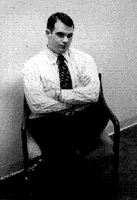| |

|
|
|
|
REVEALING BODY LANGUAGE |
3 Pages - Page 3 |
| Evaluate the position of the limbs |
 |
Crossed arms:
Within a posture, barriers represent crossed arms or legs. While crossed arms can be a comfortable posture while standing and talking to a friend, considering the high level of motivation associated with an investigative conversation, it is inappropriate for a truthful subject to cross his arms. This behavior reflects either a challenge (generally feigned anger) or a protective gesture reflecting lack of confidence. In addition, of course, when the arms are crossed the person's hands are restricted from movement which is also more typical of the lying person.Left: This person may look pretty relaxed, but he has his armes and his legs crossed tight, and in combination with the snug expression on his face this man is probably lying. |
|
Crossed legs
Crossing of the legs is common in both truthful and lying postures. While seated, especially for an extended period of time, it is comfortable to occasionally cross, or re-cross the legs. However, there are some significant differences between the leg crossing behaviors of truthful and lying persons. At the outset of a serious conversation, when anxiety levels are highest and key questions are being asked, most truthful persons will have their feet flat on the floor. As the conversation progresses, and the person realizes that you are not accusatory in your questioning, it is common for the truthful person to assume a more relaxed posture, including crossed legs. On the other hand, a person who starts out the interview with crossed legs is more typical of the liar. This is a defensive posture, as though the liar wants to remain emotionally distant from you.
A truthful persons's leg cross appears comfortable and relaxed. Whether it is an ankle-knee cross or knee-knee cross, the person's muscles are non-contracted and loose. On the other hand, the lying person's leg cross is often tight and restricted, where muscles are contracted. A good example of this is the leg cross in which the person actually grabs the ankle to bring it up higher on the thigh. |
| |
| Changes in posture |
| As previously mentioned, a truthful person will display a number of different postures during the course of a conversation. The timing of these posture changes will be natural. Conversely, it is highly indicative of lying when posture changes occur on cue to a question, such as the crossing or re-crossing of the legs, or a shift in the chair where a person often uses his hands to momentarily lift or move his body within the chair. You should look for these shifts during two significant time frames.
The first is just before the person answers a question:
Q: "So you were working at the office all night long?"
A: (Shift in chair) "Yes, I really had to finish that report."
The second significant timing is during the person's verbal response:
Q: "Were you receiving any special phone calls last month?"
A: "Nothing out of the ordinary. (Shift in chair) That I can recall." |
| |
| Conclusion |
In conclusion, a person's posture can offer meaningful information during a conversation. As with all of the behavioral assessments that I teach at my course Truth or Lie, there are more factors, for instance eye movement behaviour, that may reveal deceptions from a little white lie to an enormous whopper, and must be considered as well.
The analysis above can be used for the workplace with job interviews and client reliability, but also for the interrogation of lying family members - children and adults alike. Keep in mind that some children have mastered the art of lying so well that they can easily compete with adults! |
|
|
|








|